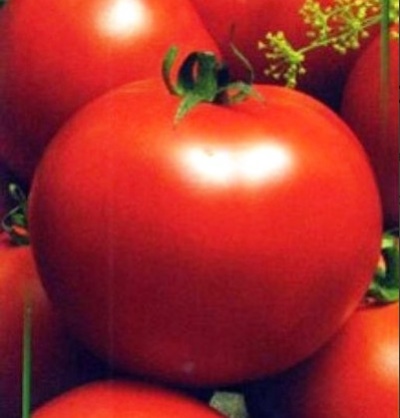
- Authors: Vasiliev Yu.V., Vinogradova A.F.
- Year of approval: 2007
- Category: grade
- Growth type: determinant
- Appointment: fresh consumption
- Ripening period: early
- Ripening time, days: 95-100
- Growing conditions: for open ground, for film greenhouses
- Bush height, cm: 90-100
- Leaves: medium, green
With the start of the new planting season, summer residents and farmers are looking for tomatoes to grow on the plots. Along with the numerous novelties offered by breeders, one should not forget about the classic varieties, including the early-ripe Hermitage tomato.
Breeding history
The early Hermitage tomato was bred by Russian breeders A.F. Vinogradova and Yu.V. Vasiliev in 2003. 4 years later, in 2007, the culture was entered into the State Register of Breeding Achievements of the Russian Federation and allowed for use. A variety was created specifically for the North-West region, but over time, the geography of growing this type of tomato has expanded significantly. The plant also grows in garden beds, in film greenhouses.
Description of the variety
The Hermitage is a medium-sized plant of the determinant type, reaching a height of 90-100 cm. The branches of the bushes are compact, moderately thickened with green foliage, the root system is well developed, and the inflorescences are of a simple type. A healthy bush forms 6-8 fruit clusters, where 7-9 berries are tied. During the cultivation of tomatoes, you will need the formation of bushes in 2-4 stems, the obligatory removal of stepchildren, as well as a garter of trunks and branches to the supports. Tomatoes have a salad purpose, therefore they are ideal for fresh consumption, for preparing salads, for processing into juices, pasta, mashed potatoes.
The main qualities of the fruit
The Hermitage tomato is a representative of medium-sized nightshade crops. The average weight of a tomato is 100 grams. The shape of the vegetable is correct - flat-round with barely visible ribbing. A ripe vegetable is evenly covered with a rich red color, and in the ripening phase - green. The peel of the berries is of medium density, without hardness, glossy. The tomato does not crack, it tolerates transportation well, and is also stored for a long time without losing its taste and marketability.
Taste characteristics
The vegetable has a classic, tomato, balanced taste. The flesh of the fruit is dense, fleshy, medium juiciness. The taste is present in equal proportions of sourness and sweetness, complemented by a spicy aroma that many varietal tomatoes have. There are few seeds in the pulp, no wateriness is observed.
Ripening and fruiting
Hermitage tomatoes are early ripe. From the moment of germination of seedlings to the appearance of ripe berries on the bushes, it takes 95-100 days. The fruiting period of the variety is extended. The active phase of maturation and fruiting begins in the second half of June and lasts until the end of summer.
Yield
The yield indicators of the variety are good. With proper agricultural technology, up to 7 kg of delicious tomatoes can be grown per 1 m2. When grown in a greenhouse, a tomato is more productive, so it can produce 4-5 kg from one bush.
The timing of planting seedlings and planting in the ground
The Hermitage tomato is grown in seedlings. Sowing seeds is carried out from mid-March. The seeds are pre-sorted out, disinfected in a solution of potassium permanganate. Germination of sprouts occurs on the 5-7th day. To improve the process, you can cover the boxes with seedlings with glass or plastic. The room where the bushes grow should be warm, from 20 to 24 degrees, and light. At the stage of the appearance of 2-3 leaves, the bushes are planted in separate cups.During this period, it is necessary to apply fertilizers, irrigate. For quick adaptation of the bushes to a new place, you can prepare them in advance - harden them.
Seedlings are transplanted at the age of 60-65 days, when 6-7 leaves have grown on each bush and one flower brush has formed.

Growing tomato seedlings is an extremely important process, because it largely depends on whether the gardener can harvest at all. All aspects must be taken into account, from seedbed preparation to planting in the ground.
Landing scheme
It is necessary not only to provide watering and feeding the plants, but also to plant them correctly in the garden. It is worth having 3 tomato bushes per 1 m2, no more. The recommended scheme for planting is 40x50 cm.

Growing and care
Before planting seedlings, you should choose an area that should be free of weeds and well-lit by the sun. The soil should be loose, fertile and breathable. The best place will be where the zucchini, cucumber or radish used to grow. Caring for tomatoes includes watering, fertilizing, weeding the soil, forming and tying bushes, pinching, and protecting against insects and viruses.




A plant needs different micronutrients at each stage of growth. All fertilizers can be divided into two groups: mineral and organic. Folk remedies are often used: iodine, yeast, bird droppings, eggshells.
It is important to observe the rate and period of feeding. This also applies to folk remedies and organic fertilizers.
Disease and pest resistance
This species has a high disease resistance to many diseases of nightshade crops - tobacco mosaic virus, fusarium wilting, cladosporium, Alternaria. In addition, early ripening allows tomatoes to bypass late blight. Protection from the invasion of pests will be provided by treatment with biological products.
Resistant to unfavorable weather conditions
Tomato has high stress tolerance. It tolerates return frosts, temperature fluctuations, short-term shade and heat well.Weak immunity of the culture to drafts and excessive moisture, due to which some diseases can occur.



























































































